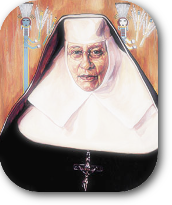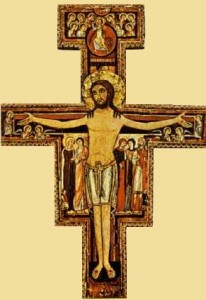May the Peace of the Lord be with you!
I have had the privilege and pleasure of visiting Fraternities in our Region especially over the last three months. At some of the gatherings I sat in on formation lessons, others just for a visit to see what was going on and to offer any help needed. In a few fraternities I was part of the ongoing formation and I used the San Damiano Cross as the topic of instruction. Not only did Francis hear the Lord calling him to service but there are also so many other figures on the cross to learn about.
We examined each figure on the Cross and discovered that all the figures next to Jesus are the same size, the Mother of God and John under the protection of God’s hand, a small faced unidentified participant, and, among the many other figures, trying to find the Rooster was an especially graced moment, producing many laughs. The most interesting observation for me, however, was the discovery of the shells that go all around the outside of the cross. They symbolize the celebration of life from the depths of the deep to the highest heavens.
Here are some facts about the church of San Damiano:
This is the church that Francis restored in 1205 after Jesus miraculously spoke to him.
It was the first cloister for the Poor Clares and where Francis came in his illness to be cared for by Clare and her sisters at the end of his life.
Here he wrote “The Canticle of the Creatures.”
At his death his body was passed through the small window in the apse to be reverenced by Clare and her sisters one final time.
Clare died there in 1253.
Today San Damiano is occupied by the friars and remains much as it was in the time of Francis and Clare.
Did you know ???
Above is a native American version of the San Damiano Cross with a Navajo Christ painted by Linda Benton in 1995, for the church in Tohatchi, New Mexico. A picture was sent to St. John Paul lI, and is a part of the Vatican collection as he had an interest in this cross. All the large figures on the cross, Mother Mary, Mary Magdalen, and John are all Navajo. A United States Cavalry officer replaces the Roman centurion. The Angels above and looking downward are Native Americans and a Franciscan friar and Spanish conquistador in the corners, act as witnesses. In the Native American tradition the San Damiano Cross is done in sandpainting.
God Bless,
Rosie


![tohatchicross[1]](http://www.skdregion.org/wp-content/uploads/tohatchicross1-225x300.gif)